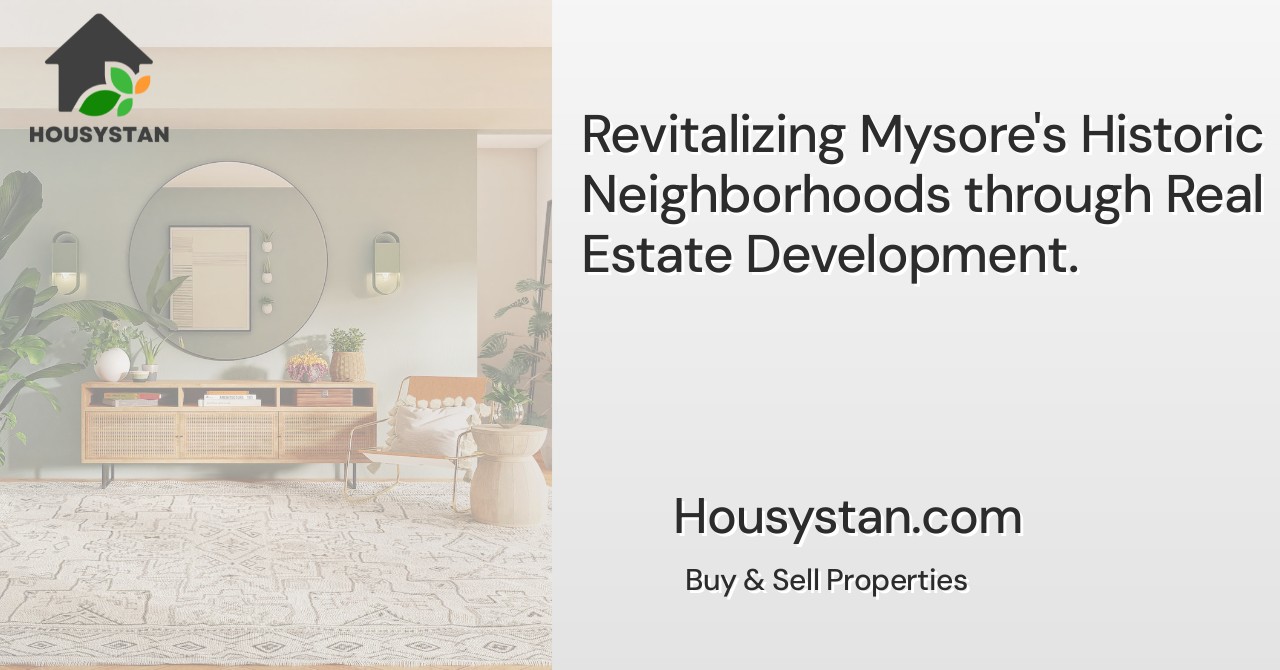Revitalizing Mysore's Historic Neighborhoods through Real Estate Development
Read latest blogs and articles from Housystan

The Information mentioned here was last updated on:
25/11/2025Revitalizing Mysore's Historic Neighborhoods Through Real Estate Development
Mysore, a city rich in history and culture, is renowned for its majestic palaces, vibrant festivals, and exquisite architecture. But beyond these classical elements lies a tapestry of neighborhoods waiting to be revitalized. Bringing new life to these areas offers significant benefits, not just in preserving history, but also in boosting the local economy through real estate development. This can transform Mysore into an even more dynamic city, blending the charm of the past with the promise of the future.
The Historical Significance of Mysore’s Neighborhoods
- Verified Tenants/Buyers
- Unlimited Property Listing
- Zero subscription/charges fee
Mysore’s historic neighborhoods, such as Mylapore and Lakshmipuram, are treasure troves of stories and architectural wonders. These areas are lined with traditional homes, often characterized by their unique colonial and vernacular architecture. The narrow streets echo with tales of the city’s rich past, offering a glimpse into the early days of the Wodeyar dynasty and the British colonial era.
- Cultural Landmarks: Many historic neighborhoods house important cultural landmarks that speak to Mysore's heritage. Major temples, educational institutions, and traditional marketplaces are integral to the cultural fabric.
- Architectural Heritage: The architecture features a blend of Indo-Saracenic styles. These reflect the synthesis between native and colonial influences, making them ideal for tourism-driven revitalization projects.
Why Revitalize Historic Neighborhoods?
1. Preservation of Culture and Heritage: Reviving these areas helps preserve cultural identities and keeps traditions alive. Restoration not only venerates the past but also educates future generations.
2. Economic Growth and Employment: Real estate development in historic neighborhoods often revitalizes local economies, creating jobs in construction, tourism, and hospitality.
3. Sustainable Urban Development: Revitalization promotes sustainable practices by integrating old structures with modern amenities without erasing the historical essence.
4. Increased Property Values: Redevelopment often leads to increased property values, attracting investors and residents alike, creating a thriving real estate market.
Strategies for Successful Real Estate Development
For revitalization to be successful, it requires a careful balance of modernity and tradition. Here are some strategies:
Engaging Local Communities
- Community Involvement: Engaging with residents and stakeholders is crucial. Active community participation ensures that developments are sympathetic to the needs and desires of current inhabitants.
- Local Governance Collaboration: Working with local government to ensure developments adhere to heritage conservation guidelines and regulations.
Preserving and Enhancing Architectural Identity
- Adaptive Reuse: Transform old buildings for modern purposes without altering historical features. This might involve converting grand old homes into boutique hotels or cultural centers.
- Conservation Workshops: Implement workshops and training programs to teach traditional building methods and materials. This empowers the community to maintain heritage aesthetics.
Incorporating Green Spaces
- Urban Greenery: Incorporating parks, gardens, and green roofs reduces urban heat and enhances livability. Green spaces are not only aesthetically pleasing but also improve community health and wellbeing.
Promoting Tourism
- Cultural Tourism Initiatives: Develop cultural tours that highlight the unique history of the neighborhoods. Partnering with tourism boards to promote these initiatives can lead to increased visitor traffic.
- Heritage Festivals: Organize festivals that celebrate local history and culture, drawing attention and visitors to these areas.
Potential Challenges and Solutions
Resistance to Change
- Community Engagement: Alleviate resistance by involving residents in planning processes. Clear communication about the benefits and impacts of development can promote acceptance.
Funding Constraints
- Public-Private Partnerships: Collaborate with private investors and government bodies to secure funding. Joint ventures can spread the risks and benefits, ensuring the project remains financially viable.
Regulatory Hurdles
- Streamlined Processes: Work with authorities to ensure regulations are clear, and processing times are minimized. Creating special economic zones (SEZs) for heritage sites might also offer tax incentives and simplify bureaucratic hurdles.
Leveraging Technology in Revitalization
- Virtual Reality (VR) Tours: Utilize VR technology to create immersive experiences for potential investors and tourists, allowing them to explore neighborhoods digitally before visiting physically.
- Smart Solutions: Implementing smart city technologies, such as advanced infrastructure management systems, can enhance efficiency without compromising heritage values.
The Role of Education and Awareness
Educating the public about the value of preserving historic neighborhoods is essential. Awareness campaigns can highlight the economic, cultural, and social benefits of revitalization.
- Workshops and Conferences: Hosting events focused on heritage conservation can inspire and inform key audiences, including developers, policymakers, and the community.
- Collaborations with Universities: Partnering with academic institutions for research and development initiatives ensures that projects are guided by the latest best practices and innovations.
Conclusion
Revitalizing Mysore’s historic neighborhoods through real estate development presents a unique opportunity to celebrate the city’s rich heritage while embracing modern growth. By combining conservation efforts with sustainable development practices, these neighborhoods can flourish, preserving their stories for future generations while contributing to Mysore’s economic and cultural tapestry. As the city evolves, balancing tradition with innovation remains key to its ongoing transformation.